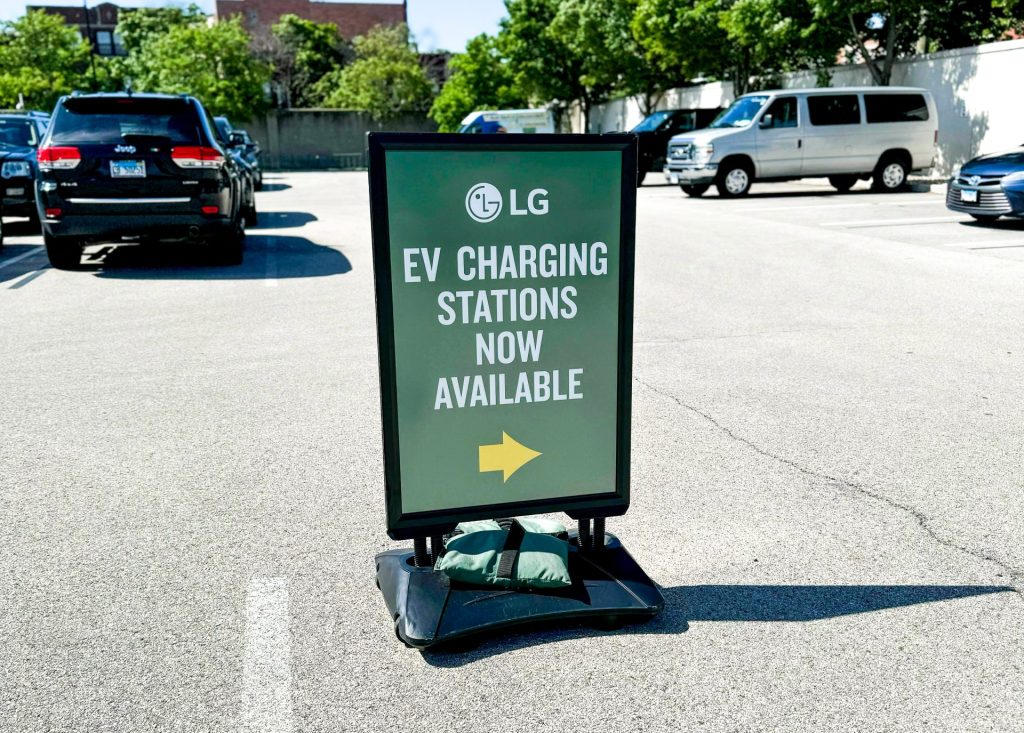
Chicago’s iconic Wrigley Field baseball stadium has been home to the MLB’s Chicago Cubs for over a century – and now, it’s taking steps to cater to the next generations of fans by adding EV charging to its list of amenities.
LG Electronics announced the installation of ten L2 EV charging stations at one of the parking facilities servicing Wrigley Field as part of a broader commercial package between LG and the team/stadium. The chargers operate on the SWTCH platform, which enables the Cubs organization to, “optimize its pricing structure for different events.”
Sure — surge pricing is terrible and should be a universally reviled practice, but you can’t argue with the flexibility that variable pricing offers large venues, and the ability to offer discounted or even free charging during otherwise quiet parking days is one possible silver lining there.
“The availability of these new charging stations near Wrigley Field is helping kick off the new season and demonstrating the forward-thinking approach necessary to help fans at the Friendly Confines and Wrigleyville community embrace electric vehicles without reservations,” said Michael Kosla, senior vice president, LG Business Solutions USA. “Working directly with the Cubs, SWTCH and LG customized the charging stations’ software to manage power, optimize performance and ensure seamless guest experiences.”
The addition of EV charging is an important step forward for Cubs fans with electric vehicles. The ten ports are available on a first-come, first-served basis — and are (ironically) located in Wrigley Field’s Toyota Camry (not an EV, or even a PHEV) parking lot.
Electrek’s Take


When it comes to electrification and combating climate change, I like to celebrate every positive step forward. And, while the addition of EV charging to a major Chicago landmark is certainly that, I can’t help but notice that this project highlights one of the biggest (in my opinion) issues facing widespread understanding of the depth and breadth of America’s current EV charging infrastructure: proper signage.
Look at that tiny sign announcing the new EV charging stations. If you weren’t looking for it, you could easily miss it … and when was the last time you “missed” a gas station? Compare that little green sign to the sixty foot tall, illuminated signs advertising gasoline in the photo of Breezewood, Pennsylvania shown, below …
Oil companies are loud

… I count at least eight different places that I could buy gas or diesel. From left to right, BP, Sheetz, Exxon, Mobil, Texaco, Sunoco, Shell, and Citgo. Heck, that might not even be all of them!
Even if I don’t plan on buying fuel here in Breezewood, I know it’s there. There when I want it, there if I need it. Perpetually there, sure as the moon and the tides. EV charging, meanwhile? Are there even any EV chargers in Breezewood?

Plugshare says there’s a bunch. Fully twenty-eight public-facing DCFC ports, in fact — with more to come at the Flying J, TA Travel Center, and more “behind-the-fence” ports likely already in place. But, without the same signage, how is the average American whipping past Breezewood supposed to know?
For as long as the charging networks insist on leaving their marketing to apps and resist the inevitability of putting up signs that proclaim their availability, for when you want to charge and when you need to charge, there will always be a sense that the EV charging infrastructure is somehow “less than” the oil business’ infrastructure — despite the reality being a very, very different thing.
SOURCES | IMAGES: SWTCH, Plugshare.
FTC: We use income earning auto affiliate links. More.

